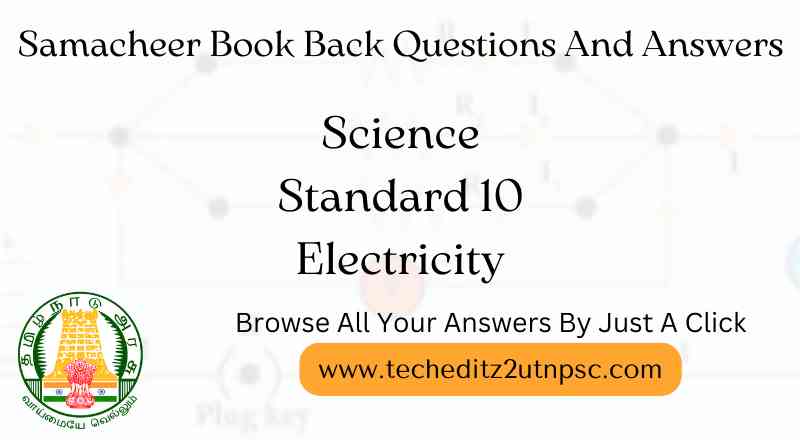support@techeditz2utnpsc.com | 8300-921-521

Electricity
Samacheer Book Back Questions And Answers For Science Standard 10 “Electricity“
I. Choose the best answer:
1. Which of the following is correct?
a) Rate of change of charge is electrical power.
b) Rate of change of charge is current.
c) Rate of change of energy is current.
d) Rate of change of current is charge.
2. SI unit of resistance is
a) mho
b) joule
c) ohm
d) ohm meter
3. In a simple circuit, why does the bulb glow when you close the switch?
a) The switch produces electricity.
b) Closing the switch completes the circuit.
c) Closing the switch breaks the circuit.
d) The bulb is getting charged.
4. Kilowatt hour is the unit of
a) resistivity
b) conductivity
c) electrical energy
d) electrical power
II. Fill in the blanks:
1. When a circuit is open, _____ cannot pass through it.
2. The ratio of the potential difference to the current is known as _____.
3. The wiring in a house consists of _____ circuits.
4. The power of an electric device is a product of _____ & _____.
5. LED stands for _____.
Answers:
1. current
2. resistance
3. parallel
4. voltage and current
5. Light Emitting Diode
III. State whether the following statements are true or false: If false correct the statement:
1. Ohm’s law states the relationship between power and voltage.
2. MCB is used to protect house hold electrical appliances.
3. The SI unit for electric current is the coulomb.
4. One unit of electrical energy consumed is equal to 1000 kilowatt hour.
5. The effective resistance of three resistors connected in series is lesser than the lowest of the individual resistances.
Answers:
1. False (Ohm’s law states the relationship between current and voltage)
2. True
3. False (The SI unit for electric current is the ampere)
4. False (One unit of electrical energy consumed is equal to kilowatt hour)
5. False (The effective resistance of three resistors connected in series is greater than the highest of the individual resistances)
IV. Match the following:
1. electric current A. volt
2. potential difference B. ohm meter
3. specific resistance C. watt
4. electrical power D. joule
5. electrical energy E. ampere
Answers:
1. E
2. A
3. B
4. C
5. D
V. Assertion and reason type questions:
1. Assertion: Electric appliances with a metallic body have three wire connections.
Reason: Three pin connections reduce heating of the connecting wires
a) if both the assertion and the reason are true and the reason is the correct explanation of the assertion.
b) if both the assertion and the reason are true, but the reason is not the correct explanation of the assertion.
c) if the assertion is true, but the reason is false.
d) if the assertion is false, but the reason is true.
2. Assertion: In a simple battery circuit the point of highest potential is the positive terminal of the battery.
Reason: The current flows towards the point of the highest potential
a) if both the assertion and the reason are true and the reason is the correct explanation of the assertion.
b) if both the assertion and the reason are true, but the reason is not the correct explanation of the assertion.
c) if the assertion is true, but the reason is false.
d) if the assertion is false, but the reason is true.
3. Assertion: LED bulbs are far better than incandescent bulbs.
Reason: LED bulbs consume less power than incandescent bulbs.
a) if both the assertion and the reason are true and the reason is the correct explanation of the assertion.
b) if both the assertion and the reason are true, but the reason is not the correct explanation of the assertion.
c) if the assertion is true, but the reason is false.
d) if the assertion is false, but the reason is true.
Visit Our YouTube Channel For More Free Videos: Click Here


